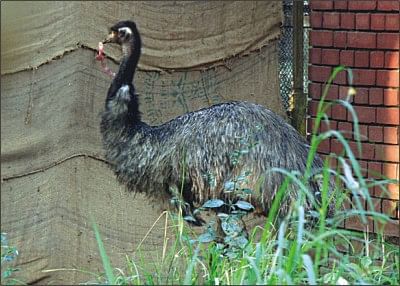25 lone inmates at Dhaka Zoo

The last of the ostriches walks inside its coop at Dhaka Zoo.Photo: STAR
More than 25 species of animals in Dhaka Zoo have been living a lonely life in their cages for long that can have a serious effect on their life, say experts.
The animals include a chimpanzee lone for around 12 years, Malayan tapir locked up alone for 9 years and a rhinoceros lonely for around four years. Besides, there are civet, bearcat, honey badger, grey squirrel, guinea baboon, hyena and Asian elephant on the list of the lonely animals.
Among birds, oriental magpie robin (doel), the national bird of Bangladesh, ostrich, turkey, cockatiel, grey pelican (spot-billed pelican), crane, cuckoo, crested cockatoo, owl, brown-winged kingfisher, albino crow, purple moorhen, white breasted water hen, seagull are also left with a melancholic life in their cages.
Among these animals, Asian elephant, bearcat, hyena and cuckoo have company from their own species but they all belong to the same gender. Others are living a completely distressed solitary life.
Some of these animals belong to the list of endangered or threatened species.
According to the IUCN (International Union for Conservation of Nature) red list chimpanzee, Malayan tapir and Asian elephant are endangered. Rhinoceros, civet, bearcat and sarus crane are listed as vulnerable and guinea baboon, grey pelican and brown-winged kingfisher belong to the list of near-threatened category.
Md Anwarul Islam, a professor of zoology at Dhaka University and chief executive of the Wildlife Trust of Bangladesh, said, “Like humans, animals also like to live in a community. A solitary life especially when locked up in a cage can be extremely painful and can have a fatal effect on animals. It is like punishment.”
“But more importantly a zoo has more than one purpose. Apart from entertaining and educating people it has to play an important role in conservation by promoting breeding programmes in captivity. Keeping animals without a partner means a zoo is missing out on their major responsibility of conservation,” he added.
Bird expert Mohammad Mostafa Feeroz, a professor of zoology at Jahangirnagar University, said, “Solitary life in captivity can change the behaviour of an animal. They might become violent, which often inflict self-injury”
“Especially in the mating season if they do not have a partner, these animals become more depressed which can make them physically ill,” the professor added.
Dr Aminur Rahman, curator of Dhaka Zoo, said these animals became single as their partners have died. “Letters have been sent to the ministry with plans to procure several pairs of new animals,” he told Star City.
“We have decided to procure several new young pairs instead of finding a match for these animals. We are having trouble pairing them up for long as some of the inmates are quite old in age. Our experience shows pairing them with younger animals turns fatal,” said the curator.
“Besides, it will not be cost effective to spend money on purchasing older animals, which will not live long. Younger pairs is a better solution,” he added.
Dr Rahman also said sale of some of the animals, including chimpanzee, tapir and rhinoceros, is restricted by international laws or in their country of origin. These animals cannot be collected without a state-level gift or donation.
At the moment the Dhaka Zoo will not go for purchasing any birds to avoid any possible infestation of bird flu, he said.
Formally opened in 1974, the zoo is currently home to around 2,050 animals from 165 species. Of them, 58 are mammals including elephant, Royal Bengal tiger, lion, cheetah, rhinoceros, zebras, different species of monkeys, hippos and more.
There are 66 species of birds, 13 species of reptiles including snakes and crocodiles and 28 species of fish in the zoo.

 For all latest news, follow The Daily Star's Google News channel.
For all latest news, follow The Daily Star's Google News channel. 



Comments